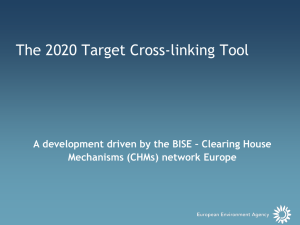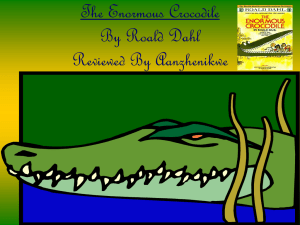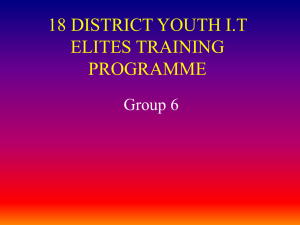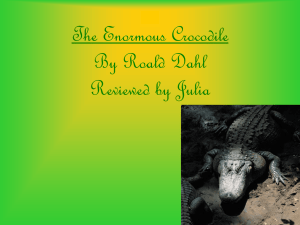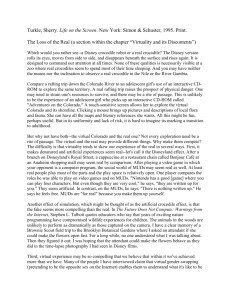Cambodian Crocodile Conservation Program (CCCP)
advertisement
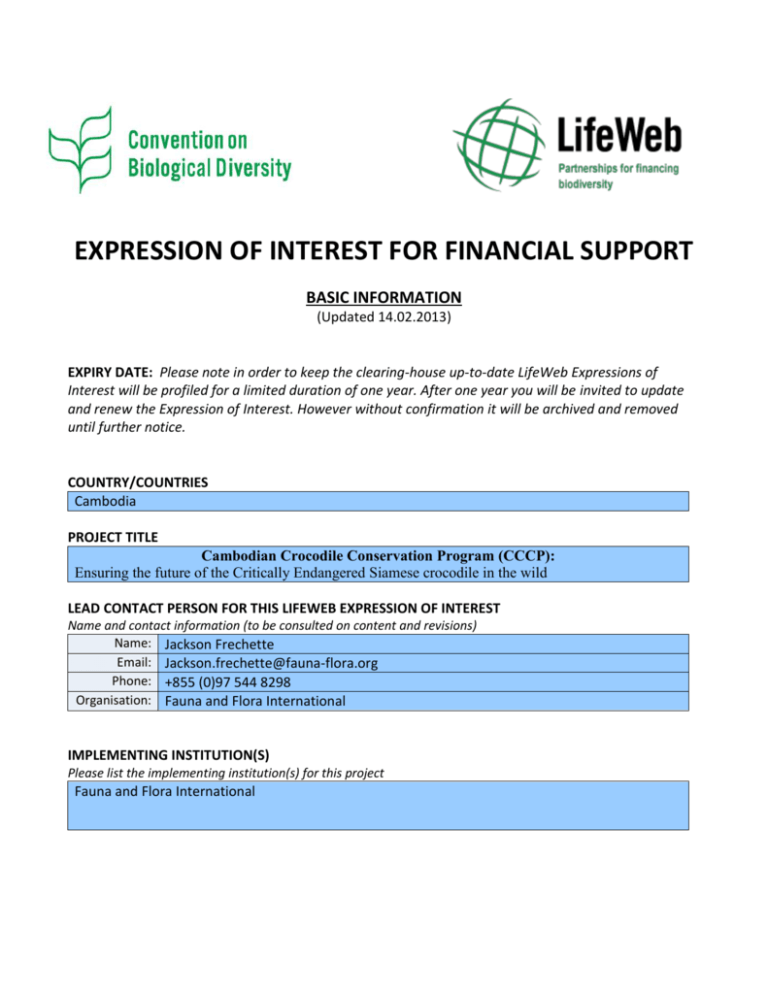
EXPRESSION OF INTEREST FOR FINANCIAL SUPPORT BASIC INFORMATION (Updated 14.02.2013) EXPIRY DATE: Please note in order to keep the clearing-house up-to-date LifeWeb Expressions of Interest will be profiled for a limited duration of one year. After one year you will be invited to update and renew the Expression of Interest. However without confirmation it will be archived and removed until further notice. COUNTRY/COUNTRIES Cambodia PROJECT TITLE Cambodian Crocodile Conservation Program (CCCP): Ensuring the future of the Critically Endangered Siamese crocodile in the wild LEAD CONTACT PERSON FOR THIS LIFEWEB EXPRESSION OF INTEREST Name and contact information (to be consulted on content and revisions) Name: Jackson Frechette Email: Jackson.frechette@fauna-flora.org Phone: +855 (0)97 544 8298 Organisation: Fauna and Flora International IMPLEMENTING INSTITUTION(S) Please list the implementing institution(s) for this project Fauna and Flora International ABSTRACT Please briefly describe the project in two to three sentences and explain why it is important to conserving biodiversity, addressing climate change, securing livelihoods and contributing toward the achievement of areabased Aichi Targets of the Strategic Plan for Biodiversity 2011-2020 This project sets out to re-establish viable, breeding populations of Siamese crocodiles in Southwest Cambodia, by using both reintroduction (releasing crocodiles into areas from which the species has been completely wiped out) and reinforcement (adding crocodiles to existing, severely depleted colonies). It also aims to strengthen the protection of existing breeding populations in Southwest Cambodia. By establishing crocodile sanctuaries we are securing watersheds which helps secure livelihoods maintain and protecting fisheries. Water security is also an important climate change mitigation. Our program protects and increases the world’s largest wild population of Siamese crocodiles, which falls directly in-line with Aichi Target 12. Our project enhances protection on the national and community level (Aichi 2,12,14, 15, 18), increases education and awareness on a local and national scale (Aichi 1), and provides data on the ecology and population status of the species (Aichi 17, 19). This project builds on over a decade of work by Fauna & Flora International’s Cambodian Crocodile Conservation Project. GEOGRAPHIC SCALE Please select one of the following. X Multinational National Sub-national LINKS WITH THE WORLD DATABASE ON PROTECTED AREAS If this project’s scope involves protected areas registered in the World Database on Protected Areas, please include the URL links where the sites appear on http://www. protectedplanet.net of all the areas involved in this project. If the area(s) are not registered in the WDPA, please indicate the complete name(s). http://protectedplanet.net/sites/Central_Cardamom_Mountains_Protected_Forest MAPS Please send high quality digital GIS files or scanned maps situating and describing the project area. These files may be made available for download on the LifeWeb website and may be used in CBD and LifeWeb communication materials Name of attachment 1. Description Crocodile sanctuary.png A map our project focal areas in the Cardamom Mountain landscape. 2. 3. Add additional rows as needed. Alternatively, please indicate latitude and longitude coordinates for the center of the project. For help, see: www.getlatlon.com. Latitude Longitude 2 Note: if the LifeWeb Expression of Interest includes protected areas that are not included in the World Database on Protected Areas and are not visible on the http://www.protectedplanet.net, you will be directed, through the process of submission, to the manager of the World Database on Protected Area to ensure the areas are represented correctly on the global protected areas map as noted in CBD COP IX/18, para 11. IMAGES Please send high quality images and any additional media (videos, web pages, brochure, etc.) of the project. Please note that images will be used to profile your Expression of Interest on the CBD LifeWeb Website and may also be used for other CBD LifeWeb communication materials. Please note that at least one image is required. Name of attachment 1. 2. 3. Description Siamese Crocling.jpg One of the newborn Siamese crocodiles in our captive breeding program Female Siamese Croc.jpg A female Siamese crocodile http://www.faunaOur webpage detailing some more information about crocodiles and flora.org/species/siameseour work. crocodile/ Add additional rows as needed. PROJECT DESCRIPTION LOCAL CONTEXT AND PROBLEMS TO BE ADDRESSED BY THE PROJECT Please describe the context and challenges (including threats to biodiversity) in the area. You are welcome to attach supporting documents. After many decades of habitat loss, hunting and collection for crocodile farms, the Siamese crocodile, Crocodylus siamensis, is at very high risk of extinction in the wild throughout Asia and is listed as Critically Endangered and on Appendix I of CITES. Cambodia still holds the biggest known wild population (up to 250 adults), and has made good progress to strengthen the protection of this species in the wild. Community-based initiatives have proved to especially effective. However, Cambodia’s crocodile population is severely fragmented and still faces many pressures, including accidental drowning in fishing nets and loss of critical habitat to hydropower dams. Fewer than five nests are recorded in the wild every year, which is not enough to ensure the survival and recovery of Cambodia’s famous crocodiles. Our program seeks to conserve the Siamese crocodile through captive breeding to reinforce existing populations, and enhanced protection of key breeding sites. Please provide a brief description of each objective and, if possible, estimate of funding required for each, as well as the overall expected results. Please add or delete rows for objectives, as needed. OBJECTIVES MEASURABLE RESULTS FUNDING 3 NEEDED* 1. 2. 3. 4. Enhance the viability of wild populations through restocking wild populations with animals reared in our captive breeding program Get national-level protection status for crocodile sanctuaries (6 total), strengthen community management of the sanctuaries and develop management plans for them Increase awareness so that at least 10% of Cambodians are aware that the Siamese crocodile is indigenous, rare, and protected by law Monitor the crocodile populations and disseminate project methods, results, and impacts to benefit further conservation planning TOTAL FUNDING NEEDED Number of crocodiles in sanctuaries is increased, and breeding is increased Sanctuaries are approved for protected status by the government; community patrols are monitored and illegal activity within the sanctuaries is reduced; management plans are approved at the community and state level. Number of guests to the Phnom Tamao Breeding Facility; number of outreach materials produced (tv, social media etc.), surveys to indicate the public perception of crocodiles Number of individuals are assessed; Information is published - - - US$ 402,077 *Please provide amounts in USD or Euros and specify the currency. TIMEFRAME Please indicate the estimated number of years required to implement the project, ranging from 1 to 5 years. The objectives here cover a 2-year project period ALIGNMENT WITH NATIONAL PLANNING1 Consistent with decision X/31, please indicate the relevance between this submission and the following national planning processes. Please be specific and attach supporting documents in Section 5. National Biodiversity Strategies and Action Plans (NBSAPs) and action plans for implementing the CBD Programme of Work on Protected Areas (PoWPA) We are addressing a number of actions in Cambodia’s National Biodiversity Strategy and Action Plan, in which the Siamese crocodile was identified as a priority Endangered Species. These include “systematic monitoring”, “development and implementation of recovery programs”, and “measures ensuring the protection of critical habitats”. This project hits several targets and indicators under this plan (Targets: 3, 4, 6, 8, 10, 11, 14, 17, and 20). This project also fulfils several actions to support Cambodia’s Action Plans for PoWPAs through its combination of supporting community protection and management of sanctuary areas, improving national protected status of crocodile habitats, and monitoring wild crocodile populations (Key PoWPA actions: 1.2, 1.4, 2.1, 3.2, 3.5, 1 National-scale submissions must be endorsed in writing by the Ministry of Environment’s authority responsible for coordinating international cooperation. We also encourage all Expressions of Interest to be endorsed by national authorities for coordinating international cooperation, as appropriate. 4 4.2, 4.3, 4.4). Other national planning strategies (e.g. Poverty Reduction Strategies (PRSPs), National Climate Change Strategies, REDD+ strategies, National Adaptation Plans of Action (NAPAs), economic and sustainable development plans, national resource mobilization strategy, infrastructure plans, land use plans, strategies for achieving the Millennium Development Goals, etc.) One major aspect of our program is the development of the National Crocodile Conservation Action Plan. We hope that it will be finished and approved by the government by the end of 2014, or early 2015. ECOLOGICAL CONTRIBUTION Please indicate the extent to which the area(s) is/are ecological priority(s) for the national protected area system, based on contribution to ecological representation, connectivity, viability and/or irreplaceability within the protected area system. If available, please refer to the national ecological gap analysis or other geographic prioritisation exercises. Our target sites represent the largest breeding populations of Siamese crocodiles in Cambodia, and in the world. Our target sites were selected specifically because they are also unique in having ideal crocodile habitat with low population pressure. Therefore, the combination of intact crocodile populations in remote sites means that these sites are not only irreplaceable within Cambodia, but globally as well. CONTRIBUTION TO CLIMATE CHANGE Climate change mitigation Please indicate information about carbon sequestration and/or storage benefits from this project. If specific figures are currently available, please include them here. Our plan is to secure a total of 80,000 ha of forested land conserved and protected as Crocodile sanctuaries. Climate change adaptation Please indicate information about climate change adaptation benefits from this project, such as storm barriers, flood control, protection against sea level rise, enabling specific mobility in the face of climate change, etc. Our crocodile sanctuaries will protect the watersheds of the rivers from deforestation and conversion to agriculture. This will provide flood and erosion control. OTHER ECOSYSTEM GOODS, SERVICES AND LIVELIHOODS Please provide a brief description of benefits of this project to providing the following ecosystem goods and services applicable to this project. 5 Freshwater security (e.g. water provision for household consumption, industrial production, grazing and agriculture, avoiding desertification, etc.) The formation of crocodile sanctuaries will protect the watersheds of the 6 designated areas. This will help prevent the conversion of the surrounding forests to agriculture and reduce the impact that grazing animals have on water quality. The conservation of those forests will help maintain clean water for households. Food security (e.g. mitigating spread of invasive alien species, increasing fish stocks, increasing variety of local foods, conserving crop wild relatives etc.) The protection of the crocodile sanctuaries will include patrolling to prevent unsustainable fishing methods such as fishing using electric currents. Human health and wellbeing (e.g. regulating the emergence and spread of disease, increasing physical activity, providing sources of traditional knowledge, medicines, biomedical research opportunities, etc.) Income generation (e.g. tourism-related activities, harvesting of non-forest timber products, fishing, etc.) This project will employ community wardens to guard the crocodile areas. We will also support the development and preservation of non-timber forest product (e.g. cardamom) collection within the crocodile sanctuaries and surrounding forests. The protected areas will also help to maintain fish stocks by preventing illegal and unsustainable fishing practices. Cultural and spiritual enrichment (e.g. protection of natural sacred sites, sanctuary for culturally important species, preservation of pilgrimage routes, etc.) Crocodiles are a culturally important species, they are considered sacred by local ethnic minority groups. Optional: Please indicate any additional information and attach supporting documents. INSTITUTIONAL CONTEXT Please indicate the partners to be involved in this project and their roles. PARTNER NAME ROLE IN THIS PROJECT 1. Cambodian Forestry Administration (FA) 2. Fisheries Administration (FiA) 3. Ministry of Environment (MoE) FA has been a key partner in this project from its inception. Much of the work here is areas under FA jurisdiction with FA staff, including our Phnom Tamao captive breeding site. FA is a key partner is the facilitation of the Action Plan being approved at the national level. FiA will be key in helping to acquire pure-bred Siamese crocodiles from farms for the captive breeding program and release. They will be key participants in the release and monitoring of captive bred crocodiles. We will work together with MoE in the development of the national species biodiversity database. They will also be important partners in conducting surveys for crocodiles 6 in places outside our focal areas. 4. 5. Add additional rows as needed. COUNTERPART FUNDING CATEGORIES TOTAL PROJECT COST COUNTERPART FUNDING SECURED Domestic funding secured GEF allocations International funding secured ADDITIONAL FUNDING NEEDED INSTRUCTIONS SOURCE(S) Please indicate the total budget and currency required for this project. Please indicate domestic funding committed, including government budgets, private foundations and NGOs, as well as in-country financing mechanisms such as trust funds, park entry fees, water funds, airport fees, development fees, etc. Please indicate your countries’ GEF allocation that has been used towards these protected area activities. Please see here for information about national GEF allocations: http://www.gefonline.org/Country/CountryProfi le.cfm IUCN Save Our Species (2014) People’s Trust for Please indicate any funding that has been Endangered committed from international sources, including Species multilateral and bilateral donors, international (2014-15) foundations and international NGOs. Assoc. of Zoos and Aquariums Private Donors This amount should be equivalent to total project cost minus counterpart funding secured. AMOUNT 28111 12948 30704 21817 308,497 LINKS TO THE CBD PROGRAMME OF WORK ON PROTECTED AREAS The following section is to be filled in only if the project is aligned with the CBD Programme of Work on Protected Areas. Please attach supporting documents and list them in Section VI. FINANCIAL SUSTAINABILITY 7 Please indicate institutional commitments and/or sustainable financing mechanisms that will contribute to the project’s sustainability. FFI and FA are fully committed to the long-term conservation of the Siamese crocodile. The CCCP has been already operating for 14 years and both institutions are dedicated to ensuring that the program continues well into the future. FA has demonstrated their commitment to conservation with ongoing agreements with FFI. Also, the expected government approval of the National Action Plan for Crocodile Conservation will cement state level commitment for crocodile conservation. PARTICIPATION AND EQUITY Please indicate how this project will (ensure) the full and effective participation of indigenous and local communities and the equitable sharing of costs and benefits with indigenous and/or local communities. In establishment of our crocodile sanctuaries we are going through rigorous free, prior, and informed consent protocols. This involves meeting with community members, establishing and addressing their concerns, and also monitoring the effect of our activities on community members. GOVERNANCE TYPES If applicable, please explain how this project will contribute to a greater diversity of governance types in the national protected area system. N/A LINK WITH THE 2011-2020 STRATEGIC PLAN FOR BIODIVERSITY AND THE AICHI TARGETS LifeWeb facilitates financing that contribute toward the achievement of the area-based Aichi Targets in the 2011-2020 Strategic Plan for Biodiversity. Please indicate below how the proposed project contributes toward these targets. Please be specific and attach supporting documentation as necessary in Section V. AICHI TARGET 5 “By 2020, the rate of loss of all natural habitats, including forests, is at least halved and where feasible brought close to zero, and degradation and fragmentation is significantly reduced.” (CBD Quick Guide to Aichi Target 5 EN, ES, FR) Please indicate how this project contributes toward achieving Aichi Target 5 (if applicable) Our project aims to secure and protect critical crocodile habitat and 80,000 ha of catchment across the sites. AICHI TARGET 9 “By 2020, invasive alien species and pathways are identified and prioritized, priority species are controlled or eradicated, and measures are in place to manage pathways to prevent their introduction and establishment.” (CBD Quick Guide to Aichi Target 9 EN) Please indicate how this project contributes toward achieving Aichi Target 9 (if applicable) NA 8 AICHI TARGET 10 “By 2015, the multiple anthropogenic pressures on coral reefs, and other vulnerable ecosystems impacted by climate change or ocean acidification are minimized, so as to maintain their integrity and functioning.” (CBD Quick Guide to Aichi Target 10 EN) Please indicate how this project contributes toward achieving Aichi Target 10 (if applicable) NA AICHI TARGET 11 “By 2020, at least 17 per cent of terrestrial and inland water, and 10 per cent of coastal and marine areas, especially areas of particular importance for biodiversity and ecosystem services, are conserved through effectively and equitably managed, ecologically representative and well-connected systems of protected areas and other effective area-based conservation measures, and integrated into the wider landscapes and seascapes.” (CBD Quick Guide to Aichi Target 11 EN, ES) Please indicate how this project contributes toward achieving Aichi Target 11 (if applicable) Our crocodile sanctuaries are part of the greater protected area landscape in the Cardamom mountains and provide further protection for the sites within protected areas, and creates new protected areas outside formally protected forests. AICHI TARGET 12 “By 2020 the extinction of known threatened species has been prevented and their conservation status, particularly of those most in decline, has been improved and sustained.” (CBD Quick Guide to Aichi Target 12 EN, ES, FR) Please indicate how this project contributes toward achieving Aichi Target 12 (if applicable) This project directly protects the largest wild breeding populations of the critically endangered Siamese crocodile. We will also stabilize and increase the wild population through reintroduction and reinforcement from captive bred stock. AICHI TARGET 13 “By 2020, the genetic diversity of cultivated plants and farmed and domesticated animals and of wild relatives, including other socio-economically as well as culturally valuable species, is maintained, and strategies have been developed and implemented for minimizing genetic erosion and safeguarding their genetic diversity.” (CBD Quick Guide to Aichi Target 13 EN) Please indicate how this project contributes toward achieving Aichi Target 13 (if applicable) NA 9 AICHI TARGET 14 “By 2020, ecosystems that provide essential services, including services related to water, and contribute to health, livelihoods and well-being, are restored and safeguarded, taking into account the needs of women, indigenous and local communities, and the poor and vulnerable.” (CBD Quick Guide to Aichi Target 14 EN) Please indicate how this project contributes toward achieving Aichi Target 14 (if applicable) The establishment of crocodile sanctuaries protects the watersheds for several indigenous communities. AICHI TARGET 15 “By 2020, ecosystem resilience and the contribution of biodiversity to carbon stocks has been enhanced, through conservation and restoration, including restoration of at least 15 per cent of degraded ecosystems, thereby contributing to climate change mitigation and adaptation and to combating desertification.” (CBD Quick Guide to Aichi Target 15 EN, ES, FR) Please indicate how this project contributes toward achieving Aichi Target 15 (if applicable) We helping in the protection of both biodiversity and tracts of intact forest. We are also restoring the ecosystem by increasing the population or reintroducing the top predator. Contribution to any other Aichi Targets Please describe contributions to any other Aichi Target (if applicable) In establishing our crocodile sanctuaries at the national level, establishing a management plan, and facilitating and strengthening community management of the sanctuaries, our project also contributes to Aichi Targets 2, 15, 14 and 18. We will also engage in broad education and awareness campaigns, Aichi Target 1. Additionally, we will collect and disseminate ecological and population data on the Siamese crocodile (Aichi 17 and 19). ADDITIONAL PROJECT INFORMATION ADDITIONAL INFORMATION Please indicate any additional information not captured elsewhere in this Expression of Interest KEYWORDS Please check the following keywords that apply to this project. 10 Threats addressed: Encroachment and development Global climate change Inappropriate resource management policies Infrastructure for energy and transportation Invasive alien species Over-harvesting Unregulated tourism and recreation Other threat addressed Habitat Types: Arctic Coastal Coral reefs Deep seas Dry and sub-humid lands Forests Grasslands Inland waters (lakes and rivers inland of oceans) Islands Mangroves Mountains Other habitat type Other keywords: REDD-plus Climate change adaptation and/or mitigation Conflict prevention and resolution Trade Business Renewable energy Restoration Wildlife protection Endangered species Reduce deforestation Traditional knowledge Capacity building Transboundary conservation Cross-cutting issues: Access and benefit sharing Children and youth Communication and awareness building Indigenous peoples Local community management Monitoring, indicators and assessments Sustainable use Other cross-cutting issue 11 ATTACHMENTS Please indicate the file names of any supporting documents/annexes attached to this Expression of Interest. Name of attachment Description 1. 2. 3. 4. 5. Add additional rows as needed. SIGNATURE: ____________________________ July 20, 2014 DATE: ____________________________ 12
